Who doesn’t love baby animals? There is no person too old or too tough that does not turn into a cooing mess when they see the furry, scaly, or fuzzy offspring of the tiniest creatures in the world. We have put together a list of the cutest, most irresistibly adorable animal babies in the world. These are the critters that have put a smile on the saddest people’s faces and made us wish that we could adopt every single one of them.
Baby Hedgehog
You might not have known that a baby hedgehog’s technical name is a “hoglet”. This must be one of the cuter kinds of baby animals, and that is saying something given how many adorable munchkins there are in the world. Those little toes sticking out into the air are too sweet. You can also cuddle them as their spines have not developed to the point where they are painful to hold. They can curl up into spiky balls if they need to, however.
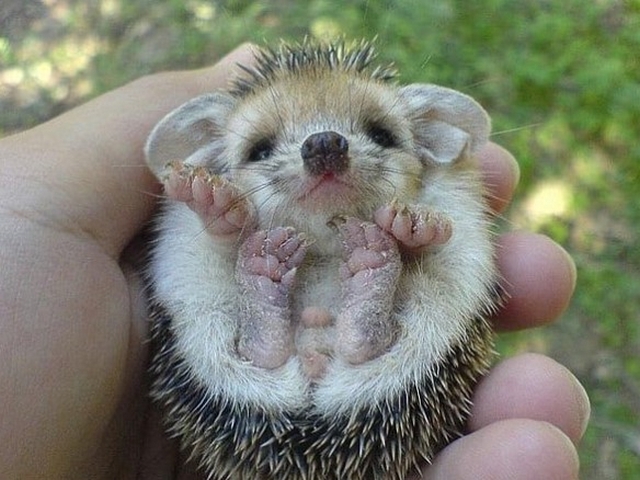
Baby Hedgehog
Baby Dolphin
Many people have written and spoken extensively on how incredibly smart dolphins are, but can we take a minute to appreciate baby dolphins? Their limbs develop in utero, which incredibly go back into their bodies and disappear just before they exit their mothers’ wombs. This points to an ancestral link to a creature that was once four-legged and lived on dry earth. Dolphins have more individual qualities that other marine animals do not have. They are far more playful than most sea creatures, loving to surf on waves and blowing rings with bubbles blown out their blowholes. They then pop their works of art with their beaks!
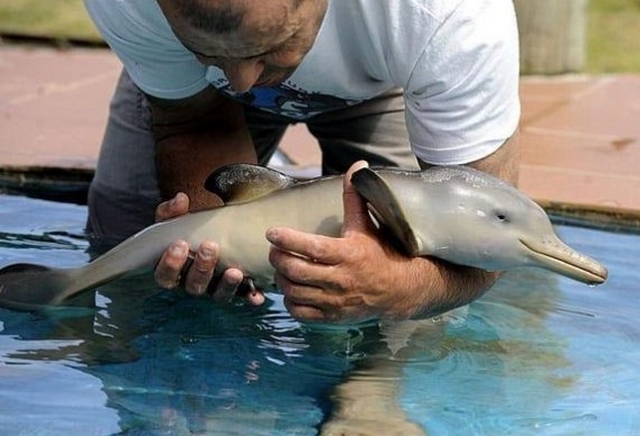
Baby Dolphin
Baby Hamster
Hamsters come into this world furless and blind. Their eyes only start working at around two weeks, when their eyes finally open. Hamster moms are pregnant for around three weeks, where a litter numbering about six to twenty babies comes into this world. Just look how petit this munchkin is! It is a great tragedy that mother hamsters will leave or even devour their young if they feel too afraid or stressed. So, if you own hamsters, make sure to always make them feel calm and adored!

Baby Hamster
Baby Kangaroo
Most Australians will know that a “joey” is a baby kangaroo. They are so cartoonishly adorable, but their journey into this world is amazing. It is in the pouch of their mothers that extends out of their stomachs that joeys are born. Here they will weigh under a gram and will measure around an inch. The joey will then suckle from within the pouch and make progressively longer journeys out of his safe and warm pouch up until the day that the joey is happy to be independent. Such an event takes place between seven and ten months of development.

Baby Kangaroo
Baby Cat
A baby cat, or kitten, is one of the more common baby animals that you might have encountered. Of course, kittens are extremely cute and could not be left out of this list. Just look at this tiny Persian kitten and realize how sweet they are. Can you find a cuter kitten than one with such a large bobblehead? We cannot handle those minuscule paws, either. Kittens have dominated the world of memes for many years now. You probably do not need much of an education on kittens, so let us continue with our other sweet baby friends.
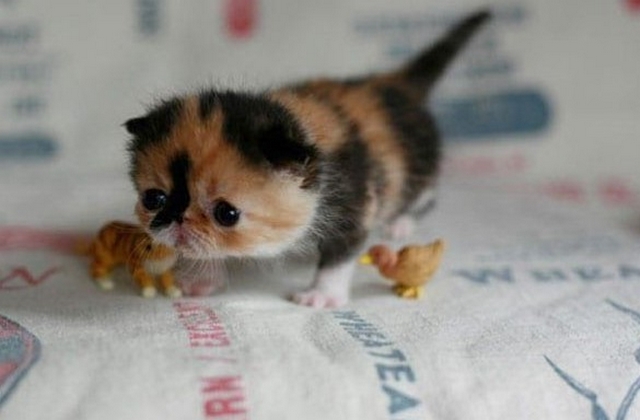
Baby Cat
Baby Stingrays
This might be an odd entry to the list, and you probably have never considered that stingrays would produce adorable offspring, but when you see how sweet baby stingrays are, you might gain a new perspective on the sea creature. You might not want to hug one, however! Stingrays swim through the sea by waving their fins with a full-body exercise. Through the use of their smell and electroreceptors, stingrays search for sustenance in the water.

Baby Stingrays
Baby Squirrel
Everyone knows what a squirrel is, at least we hope that they do, as they appear in almost every part of the world, save for Antarctica and Australia. This means that the majority of humans will spot one of these furry creatures from time to time. As for baby squirrels, they will be weaned around seven or eight weeks following their birth, at which point they will also make their way beyond their nests. These youngsters will not go very far away, however, making their new home around a mile or two from their birthplace. Squirrels are famous for inadvertently planting acorns while trying to hide food, leading to the birth of oak trees!

Baby Squirrel
Baby Pig
Have you ever seen a happier animal than this tiny piglet? Piglets might be adorable, but do not mistake them for unintelligent! They are able to recognize the voice of their mothers and will know what their name is after a fortnight. This might be incredible, but mama pigs are also able to sing their babies to sleep while nursing them! It is amazing to learn that humans are not the only ones that do this.

Baby Pig
Baby Sloth
While many of the baby creatures on this list might be too quick or elusive to be appreciated, you can be sure that a baby sloth will be too slow to escape our cuddles. The lazy sloth is incredibly unique for a variety of reasons. Firstly, baby sloths will come into this world with their eyes open and covered in fur. They will then clutch onto their moms’ bodies just seconds following their birth. Certainly, these are incredibly captivating animals. Sloths generally munch and move at a supremely leisurely pace. They will normally spend their lives existing on the same tree that they were born on.

Baby Sloth
Baby Crocodile
When it comes to the scariest creatures on Earth, you generally would consider a crocodile as the last thing you would want to encounter while out on a hike. This is why baby crocodiles are surprisingly cute! Crocodiles are among the most ancient species in our world, that was around when dinosaurs were. Baby crocodiles develop within eggs, with the temperature of the nest determining whether they are female or male. Upon birthing, the crocodile faces overwhelming odds, and only 1 percent of offspring survive being eaten by the larger foes in the wild.

Baby Crocodile
Baby Dog
The most common baby animal that humans will love, play, and raise is of course the common and domesticated puppy. Dogs have been developed into a myriad of breeds, and you can find a dog that will suit any of your needs, from guarding the home, to tracking creatures in the wild, to just being a loyal companion. As for this Teddy Bear-like pup, it is called a miniature Goldendoodle, which happens to be one of the most popular breeds in the world today.

Baby Dog
Baby Fennec Fox
The Fennec fox is a Sahara Desert native and is an incredibly unique creature. There is no tinier species of fox in the world, but that does not take away from its amazing ability to survive the desert’s punishing conditions. Their ears often grow to six inches in length. Incredibly, their heads can be tilted from one side to the other to locate their prey. Beyond that, they can release heat through their ears to cool down while traveling through the desert sun.

Baby Fennec Fox
Baby Tortoise
This adorable little guy is rushing a strawberry that is almost bigger than he is! Can you blame him for wanting to munch this delicious little fruit? Baby tortoises are not that different from adult ones, and are known as hatchlings. They do differ from their parents in one major way, and that is their increased sensitivity to temperature changes. They also adore the sunshine and love their vegetables and fruit, as you can see from the picture.

Baby Tortoise
Baby Chimpanzee
Chimpanzees are phenomenally similar to humans, and their babies are incredibly comparable to human children. This makes sense seeing as we are most closely related to chimpanzees and we share a DNA similarity of 98.5. You do not need to be a scientist to see the similarities in our facial structures. Chimpanzees are only a few evolutionary milestones behind humans. Beyond these visual comparisons, chimpanzees’ behavior is incredibly alike to human actions. They enjoy playing around and will laugh when amused, and also love giving each other hugs as a show of affection. We would give anything to hug this little chimp!

Baby Chimpanzee
Baby Giraffe
Giraffes are not the most sensible-looking creatures, and their birthing process is even crazier. A baby giraffe can look forward to a several-foot drop when it is born, given how tall their moms are, but they generally do not get hurt by this spontaneous fall. Supposedly, this process is actually incredibly important as it aids the baby giraffe to breathe for the first time. An hour later and the baby giraffe is already attempting its first steps! Can you imagine watching this entire process unfold?

Baby Giraffe
Baby Tapir
The tapir is a strange and elusive creature that many people might never have even heard of, let alone seen in person. Tapirs are incredibly rare and exotic creatures that are tragically endangered. There are all but about 3,000 tapirs remaining in the wild in modern times. This alarmingly low population is largely due to their birth rate of just one per mother. They come in a few different forms and colors that help them to camouflage in environments like the rainforest. Doesn’t this baby tapir have the most exquisite pattern?

Baby Tapir
Baby Chameleon
This amazingly tiny creature is a baby chameleon! One can find 171 species of this animal in the world, which are incredibly varied in size. These are incredibly special reptiles for more reason than one. Firstly, they are not egg layers. Rather, they birth their young! Secondly, their incredible eyes can swivel independently, which can zoom in on things. They also happen to incredibly adorable, and can blend in with their surroundings with their color-changing skin.

Baby Chameleon
Baby Alpaca
We cannot handle the adorableness of this pictured baby alpaca. Neither can many other people around the world, as the native South American fuzzy animal has been brought to many different countries. Their wool is superbly fuzzy and soft, almost as gentle as their personalities, which are amazingly sociable. They can indeed be trained to be pets and make for amazing, domesticated friends. You can bet that a sweater made from alpaca fur will keep you warm and cozy throughout the harshest winter.

Baby Alpaca
Baby Owl
We might have some trouble expressing our feelings for baby owls. Their puffy feathers, spherical shapes, and enormous eyes make for a uniquely irresistible cuteness. Like the alpaca, owls are amazingly affectionate and will often return the love. One should try not to get too attached to a baby owl during the rehabilitation process, however, as these little birds will need to return to the wild once they are old and strong enough. Wildlife workers often use owl puppets to feed babies with to make the process easier.

Baby Owl
Baby Pygmy Hippo
Here is another astonishing creature that you might have never heard of before. Let us start off by informing you that the baby pygmy hippo is an incredibly friendly creature, even if your standard hippo can be scarily ferocious. Within the animal kingdom, few creatures enjoy a pregnancy period longer than the hippo, one that lasts around eight months and results in a single offspring. Once the baby has finished bonding with its mother following a few weeks’ period, the more mature hippo will join a larger hippo group to help defend offspring from the threat of predators. This orphan baby pygmy hippo seems to have happily bonded with their human carer.

Baby Pygmy Hippo
Baby Platypus
Feast your eyes on this sweetness. Those that are having trouble identifying this wonderful specimen should know that it is a platypus, whose alternate name is the duck-billed platypus. Despite appearing like something straight out of a sci-fi film, you can believe that this is a picture taken on Earth! The platypus is a mammal of the semiaquatic variety, which lays eggs. Eastern Australia is where you can find these funny-looking creatures, including Tasmania. This is the sole species within the larger family and genus.
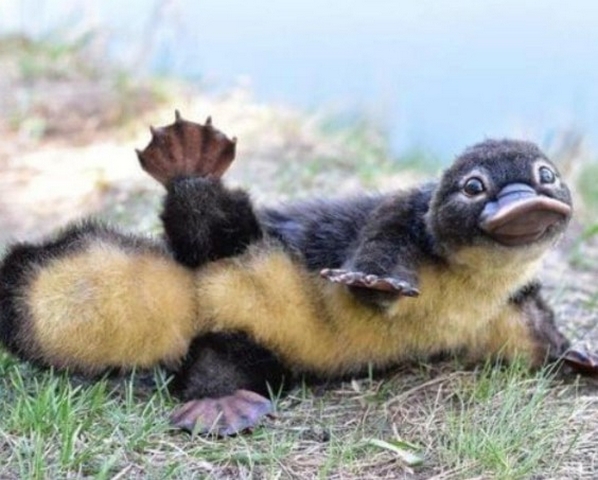
Baby Platypus
Baby Bison
Goodness, take a look at this incredible animal! This baby is doing their best to trot along with their herd, who hopefully won’t leave them behind! Upon birth, the American bison weighs in at around 30 to 70 pounds. Beyond its mother’s protection, the entire herd does its best to take care of baby bison. Adult bison can live in the wild for a period ranging between 14 and 24 years. A hard life lies ahead for this little bison, as you can see from the picture.

Baby Bison
Baby Gorilla
Why are we so naturally drawn to chimpanzees, monkeys, and gorillas? We are simply fascinated with our distant cousins, especially their magnificently cutesy babies! This little baby gorilla is tinier than our babies’ heads, which is incredible considering how large and powerful they become in adulthood. This baby was born in the Jackson Zoo and Gardens on September 28, 2018, to a proud mother named Kumbuka. The bottom picture of this baby gorilla falling asleep melted our hearts!

Baby Gorilla
Baby Okapi
We have to admit that we were completely aware of this animal’s existence until we began our research. Regardless, we cannot express our gratitude for having learned more about this wonderous being also known as a forest giraffe. The okapi is located in the Democratic Republic of the Congo in its northeast regions. It is even-toed and has zebra-like stripes and markings, which makes its relation to the giraffe all the more surprising. We would love to meet an okapi in person, but until then, this incredible picture will have to do.
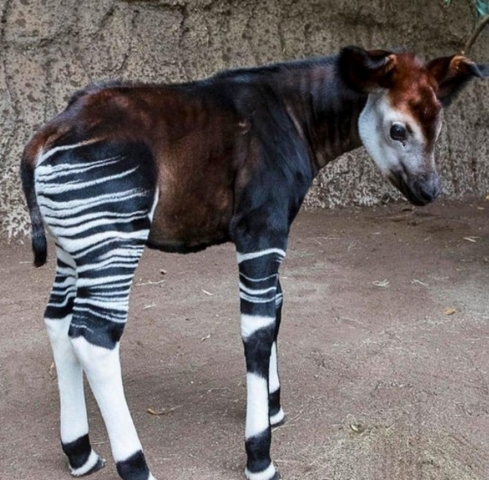
Baby Okapi
Baby Elephant
This little fellow might be having some trouble getting used to walking, but you can be sure that he will soon be proudly striding along with his enormous family members and friends. We must say that his determination is inspiring. This picture would have been taken just an hour or two following this calf’s birth, as this is the time that they will begin walking. In just a couple of days, this baby elephant will be strong enough to keep up with his herd. When we think of how long it took us to learn how to walk, this is an incredibly humbling comparison.

Baby Elephant
Baby Duck
Are you a fan of ducks? If so, then you will instantly fall in love with this curious baby duck. She could easily sit comfortably within your hand’s palm. Then there is the amazing fluffiness at hand. This is the kind of baby that you could not help but bring with you everywhere you went. Certainly, we could not get enough of this sweet-natured little treasure with his short beak and bright, beautiful eyes. We hope that he always keeps warm and happy!

Baby Duck
Baby Seal
There are few creatures cuter than a baby seal. This is a position that we are willing to defend! Our evidence extends to its enormous and curious eyes, fuzzy whiskers, and snow-white fur. The North Atlantic Oceans and the Arctic’s sea ice is where you would need to venture to in order to see baby seals in person. The pups might take their time developing blubber, but the process is sped along by suckling on their mothers’ very fatty milk. Upon reaching the 80 pounds mark, baby seals are weaned off their yummy milk source, and must then begin diving to hunt for lunch.
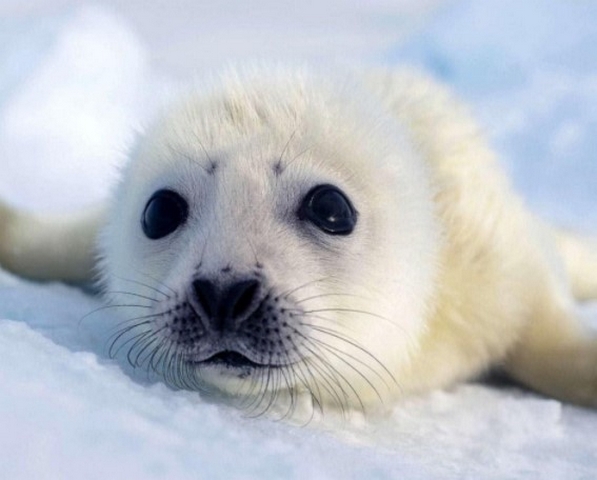
Baby Seal
Baby Frog
While amphibians may not be the most beloved creatures in the world, few people could say that baby frogs are not cute. This little guy is catching a comfortable and warm nap on a lucky person’s hand. We do not think that he will be hanging around for too long, however, as he might be a baby, but this froggy can still jump incredibly high at any moment. Just look at how incredible this baby frog’s camouflage is! It would certainly be challenging spotting this tiny specimen in a forest.

Baby Frog
Baby Pygmy Goats
While some people may be happy with the common and domesticated cat or dog, others need wilder animal companions, especially those that live in the country themselves. When you are free of the constraints that come with urban living, you can happily keep many different kinds of animals. Like this baby pygmy goat, for example! They are not just amazing pets, but fantastically sweet-natured, too. You can train one quickly, and unlike the more aggressive goats that have a habit of ramming people with their enormous horns, pygmy goats have gentle temperaments.

Baby Pygmy Goats
Baby Beaver
We sometimes struggle to believe that certain creatures are as cute as they are, especially this baby beaver! He is so sweetly munching down on leaves with an irresistibly thoughtful look on his face. Despite this baby beaver’s size and girth, he is still a little older than an infant, or a kit as baby beavers are called. Kits will be born rather large to begin with, as they need to be strong enough to swim from birth. That being said, kits will happily remain within their parents’ lodges for around a month.

Baby Beaver
Baby Koala
The fact that koalas can still thrive despite their many genetic faults is a true wonder of nature. Although koalas are infamously flawed in their design and abilities, they still completely lovable. You need only take one look at this pictured baby to understand why! Like kangaroos, koalas are known as joeys, and they will weigh about a gram when born. We think that baby koalas are cute enough to warrant a trip to the Downunder!

Baby Koala
Baby Cow
Few scenes are tenderer than a mother with her baby, as seen in this touching moment snapped by a truly talented photographer. Here, this resting calf is nuzzled by its protective and caring mother as the sun sets on this farm. This calf might seem very tiny when compared to its mother, but you can be sure that it will weigh somewhere between 60 and 100 pounds. In just an hour’s time following a calf’s birth, it will be able to stand, nurse, and walk around. It is amazing how nature pushes animals to get on with life and survival as soon as possible.

Baby Cow
Baby Valais Blacknose Sheep
Here we have a particularly cute and playful Valais Blacknose Sheep. This is a domestically bred sheep that can be seen in Switzerland’s Valais peaks. Such animals are covered in black patches that cover their knees, ears, nose, and eyes. We shall not omit the fact that their hardy wool allows them to remain cozy even in the hardest of Switzerland and Germany’s weather. These rare and wooly creatures are solely native to the aforementioned European countries. That being said, they are becoming far more popular throughout the world, and you can find growing populations across the world.

Baby Valais Blacknose Sheep
Baby Sugar Gliders
To begin with, sugar gliders are very small. To be fair, their babies are incredibly minuscule! We struggle to remain calm just looking at pictures of them and they remain adorable no matter how old they are! Why are they called sugar gliders, you may be wondering? It is because they love to eat sap and nectar, which they reach by flowing through the air! Don’t you wish that you could glide into your kitchen whenever you needed a snack?
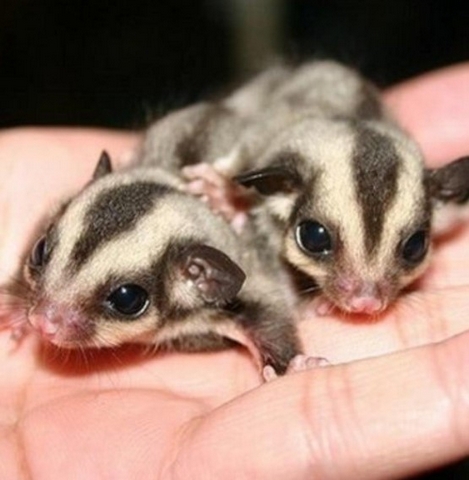
Baby Sugar Gliders
Baby Raccoon
Raccoons have pretty negative reputations wherever they live. They happen to be particularly fond of raiding farmsteads, homes, and trash cans alike during the dead of night. You might think it cruel that raccoons are so badly treated, especially when you see how lovable their babies are! Thankfully, many people take a kinder approach to raccoons and keeping them as pets has become an increasingly popular trend. Baby raccoons are called kits or cubs, and their cries mimic those of human babies. Those who want to keep a raccoon as a pet should know that their incredibly dexterous paws can turn door handles!

Baby Raccoon
Baby Rabbit
Baby rabbits are so sensationally delightful that we cannot imagine why anyone would not want to keep one (or a few) as pets. They have large, hanging ears, fur-like velvet, and an adorable hop. Rabbits are very sensitive, however, and need peaceful environments as they are easily startled and frightened. If rabbits are loved properly, their guardians will be amazed at how wonderful their personalities are, which are amazingly similar to dogs or cats. Rabbits will make a fuss if they are not properly entertained or loved. Luckily, we would not struggle to devote ourselves to such fluffy babies!

Baby Rabbit
Baby Skunk
Few people can see a skunk and not instantly become afraid of being coated in their horribly stinky spray. We might be able to put our fears aside if we met a baby skunk in person, however. Baby skunks are also called kits and will only be able to open their eyes following birth after three weeks. Following this three-week wait, skunks will rapidly develop and will be able to fall pregnant after about a year’s time. Still, we must warn against playing with skunks in general, as you could easily get hit by their appalling defense mechanism!

Baby Skunk
Baby Prairie Dog
Prairie dogs are not particularly popular in America, but that does not take away from their wonderous nature. Firstly, their mating seasons last the full duration of just a single hour, annually. Their tunnel systems are incredibly complex and they communicate through one of the most developed animal language systems known to the animal kingdom which we have yet to decode. You might find their squeaking sounds to be annoyingly monotonous, but they are actually describing in sensational detail what they are sensing to one another. You could be being described by prairie dogs loudly if they spotted you! What an incredible combination of genius and sweetness.

Baby Prairie Dog
Baby Deer
This baby deer might just be the sweetest thing that we have seen all day, with this baby being a Chinese water deer in particular. They might be cute, but they have a nasty bite, and they are known as “vampire deer” thanks to their unique fangs that develop as they grow older. You need not fear being bitten by one, however, as these fangs are generally for show. This baby is one of around 60 percent of deer offspring lucky enough to have lived through their often dangerous youth, who easily perish in just a month’s time following birth.

Baby Deer
Baby Anteater
What makes this baby anteater so adorable is how it is clutching onto this person’s arm so sleepily! The Vermilingua suborder is an umbrella term for four different species of mammal. The literal translation of this Latin word is “worm tongue”, something that might delight Lord of the Rings fans! They use this worm tongue to lap up termites and ants, which are their preferred feed. If you thought that this snoozy baby anteater bore an incredible resemblance to a sloth, it is because they are indeed very similar! Anteaters also share many traits with armadillos.

Baby Anteater
Baby Octopus
If you watched My Octopus Teacher then you might have a newfound appreciation for the intelligent, mysterious, and friendly octopus. These fascinating creatures do not live very long, but they do release countless eggs upon passing. Those that survive will hatch into these adorable little baby octopuses, which are tiny enough to happily sit on the tip of your finger! Octopuses are incredibly stealthy and ingenious creatures that can camouflage with their environments and squeeze into the tightest nooks and crannies to escape predators. If all else fails, a thick squirt of ink will allow them to make a quick getaway.

Baby Octopus
Baby Pufferfish
Those that are familiar with Japanese cuisine will know that this incredibly toxic (for the most part) group of fish is a delicacy. While we might only trust a pufferfish chef with the highest ratings on Google, the sea creatures that share an ocean with pufferfish take serious chances when they try to munch this inflatable trap. A pufferfish will generally try to escape predators by swimming away surprisingly quickly with its tail. If all else fails, the pufferfish will inflate itself with air or water, delivering a lethal dose of poison through its spikes.

Baby Pufferfish
Baby Walrus
This marine animal happens to be equally adorable to the other critters on this list. That being said, even as babies, walruses are much, much larger than most baby animals on this list! And the males will continue to grow into 4,400-pound heavyweights in adulthood. Walruses prefer to live on top of sea ice, where they scour the chilly surfaces for benthic bivalve mollusks for their diets. You can find walruses in continental shelves within the pockets of shallow waters.

Baby Walrus
Baby Chinchilla
This type of crepuscular rodent is called a chinchilla, which can only be found roaming in the wild in Chile in rare colonies. They were once prevalent in many South American countries like Argentina, Peru, and Bolivia, beyond Chile. As for their fur, it is the densest out of all terrestrial mammals. This makes them a supremely popular target of hunters and poachers, who sell their extremely gentle fur for a large profit. Sadly, this overhunting has led to their endangered status back in 2016.

Baby Chinchilla
Baby Dik-Dik
Four tiny antelope groups form the dik-dik umbrella term, which is prevalent in southern and eastern Africa. Their unique name comes from the cry that the females unleash whenever they are stressed or threatened. This is their personal alarm system. As for the males, they make quite the intense sound when threatened, which is a high-pitched whistle. You can imagine that any predator approaching a dik-dik herd would have its ears assaulted by a fearsome cacophony.

Baby Dik Dik
Baby Penguins
Penguins make up an incredibly adorable group of marine birds that are flightless. Their white and black feathers and flippers have evolved to adequately thrive within the ocean. Penguins feed on squid, krill, and fish, as well as a variety of sea life that they are able to snatch up as they swim about the water. Around 50 percent of their lifetime will be spent submerged. Although penguins are found within the Southern Hemisphere, they mainly exist within icy conditions.

Baby Penguins
Baby Donkey
Donkeys are a domesticated part of the horse family, having served humanity as beasts of burden since classical civilization. Donkeys are incredibly numerous, with more than 40 million living for the most part in developing nations. Donkeys will typically be used as pack or draught animals. Those that own donkeys will generally be linked to subsistence farming lifestyles. People will not keep donkeys as pets, for the most part. This is a shame, because we think that they are incredibly trustworthy and cute creatures, going on this picture!
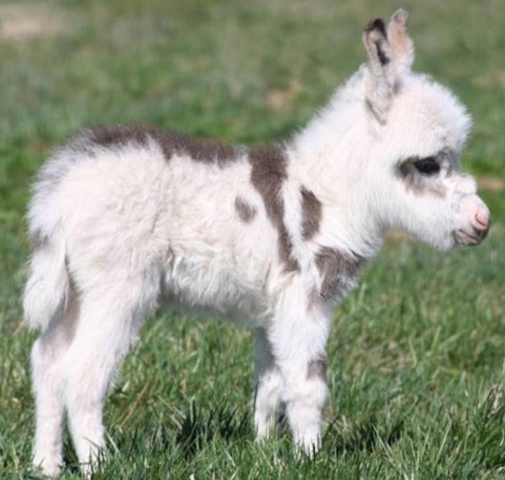
Baby Donkey
Baby Otter
We absolutely adore otters! They have to be among the sweetest members of our phenomenal animal kingdom. These semi-aquatic mammals will mostly feed on invertebrates and fish. Within a year’s time, an otter pup will go their own way, but they will learn how to swim when they are around two months of age. Generally, otters are incredibly whimsical cuties that will love and play with their friends and family energetically. They have webbed paws for maximum swimming speed and ability.

Baby Otter
Baby Black-Footed Cat
You should never underestimate the black-footed cat, no matter how adorable it is! Also known as a small-spotted cat, this beautiful munchkin is the tiniest wild cat in all of Africa. Its name comes from, as you probably guessed, its dark brown or black paws. Its wonderfully colored fur allows the black-footed cat to easily camouflage into the sunny environments that it hunts and sleeps in. Moonlit nights are its preferred conditions for hunting, where it will easily catch and eat around 14 tiny critters nightly. Its diet extends up to 40 individual vertebrates.

Baby Black Footed Cat
Baby Eastern Quoll
If the other amazing animals on this list endemic to Australia were not reason enough to convince you to book a ticket to Australia in the near future, the eastern quoll might just be the straw that broke the camel’s back. These cats are native to the Downunder, which includes Tasmania where they are amazingly popular and broadly found. It was formerly believed that quolls were extinct within the mainland, but they were later brought in 2016 to secure sanctuaries. It was in March 2018 that they were released into the wild. Their black-and-white, polka dot fur separates them from similar medium-sized carnivores.

Baby Eastern Quoll
Baby Pangolin
Pangolins can be located in Africa and Asia. Such adorable beings will come in different sizes, which begin at 30 cm and end at 100 cm. Pangolins are coated in heavy keratin scales that protect them from predators. Incredibly, pangolins are the sole creature to possess this type of armor! The different species of pangolin have their individual preferences for abodes, which include burrows and hollow trees. They feed mostly on termites and ants. Just look how adorably shy this baby pangolin looks!

Baby Pangolin
Baby Reindeers
People adore reindeers due to their association with Christmas and a certain red-nosed reindeer. Such adorable creatures are incredibly hardy, living in some of the harshest and most unforgiving regions of the world, such as the tundra, Arctic, northern Europe’s mountainous regions and the boreal, as well as North America and Siberia. Despite their widespread presence, their populations have been tragically depleted, having been labeled “functionally extinct”. We truly hope that these fantastical creatures can return to prominence in the near future through conservation efforts.

Baby Reindeers
Baby Meerkat
This small mongoose is generally located within southern Africa, and has gladly pulled back from their endangered status. The adorable meerkat will hunt tiny birds, beetles, and reptiles, and will also munch on plant materials. They are incredibly sociable creatures and exist in small to large clans that range from 2 to 30 members. Their rocky abodes are incredibly snug, which are connected to complex burrows which they dig to a diameter of around 5 meters, lined with almost 15 openings.

Baby Meerkat
Baby Red Panda
Don’t you just want to cry from cuteness when looking at this mystical baby red panda? This tiny cutie is endemic to southwestern China and the eastern Himalayas. Do not be mistaken by its misleading name, however, as the red panda does not share much in the way of relation with the giant panda. Sadly, with around just 10,000 adult red pandas living in nature, it has been labeled as endangered. The red panda is arboreal and will feed on bamboo for the most part, with added protein from insects, eggs, and birds.

Baby Red Panda
Frogmouth Chick
The frogmouth bird is a truly unique creature that is as incredible as it is strange looking. The Australian, Indian Subcontinent, and Southeast Asian-dwelling bird was named due to its titular frog-like mouth. Its wide beak allows it to easily snatch up and munch insects. Their bill is both hooked and flattened. Their large mouth makes up for their diminished flying ability, meaning that they need a larger net of sorts to compensate for their reduced mobility.

Frogmouth Chick
Baby Wombat
We are, by now, experts on Australian wildlife, but our list would not be complete without the small but powerful wombat. They have a 40-inch-long tail at maximum length, and are incredibly muscular. They can adapt to all manner of climates, and roam within mountains, forests, and heathlands. If you want a better chance of spotting a wombat, then you might want to venture out at dawn or dusk, when they are on the hunt for food. They also prefer overcast or cold days to feed.

Baby Wombat
Baby Tasmanian Devil
These carnivorous Tasmanian devils are marsupials that once upon a time roamed freely in Australia’s mainland, but today can only be located in Tasmania’s wilderness. Truly, their restricted numbers have been relocated to New South Whales. These muscular and stout creatures have dark coats and smell quite bad. Other than its rather monstrous appearance, its terrifying howls contributed to its fearsome name. Tasmanian devils hunt using their keen noses that they put to great use locating their prey.

Baby Tasmanian Devil
Baby Muskox
This exhausted-looking hoofed Arctic mammal is called a muskox, thanks to the males’ pungent odorousness that begins during mating season. Its heavy coat also contributed to its naming. In Inuktitut, the muskox is known as “umingmak” which translates to “bearded one”. This is a slightly more flattering name than “mâthi-mostos”, or “mâthi-môs,” which are the Woods Cree names for the muskox, translating respectively to “ugly bison” and “ugly moose”. Maybe this baby muskox is sad because he found out what humans call him?

Baby Muskox
Baby Boar
We now turn our attention to wild boars, who call North Africa and Eurasia their homes. Amazingly, the wild board managed to venture into Oceania and the Americas in relatively recent years in its development. As a result of its intrepid exploration, the boar can now be listed as one of the most universal creatures on Earth. Don’t be fooled by how adorable this baby boar is, as they can grow up to be quite ferocious, not to mention how invasive some groups are considered.

Baby Boar
Baby Colugo
What on Earth is this extraordinary creature? It is called a colugo, and it is a gliding mammal that lives in Southeast Asia. Those that have studied the Colugo closely realized that it was one of the most talented gliders out of all the animals capable of this ability. The thorough fur-covered membrane that extends throughout this little soaring cutie’s feet, tail, and face allows it to soar a maximum distance of 200 meters from tree to tree. Despite being excluded from the lemur family, Colugos are called cobegos or flying lemurs.
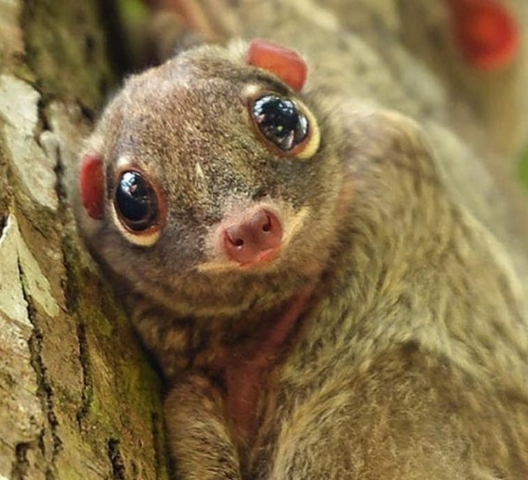
Baby Colugo
Baby Bison
Both the European and American bison together form the two leading species of the large and hardy beast in modern times. The bison became a major target for European settlers and Native Americans alike within America thanks to its incredibly thick and furry hides and meaty bodies. Native Americans consider the bison as sacred, which made its borderline extinct status toward the end of the 19th century all the more tragic. Luckily for this adorable baby bison, life seems quite peaceful.
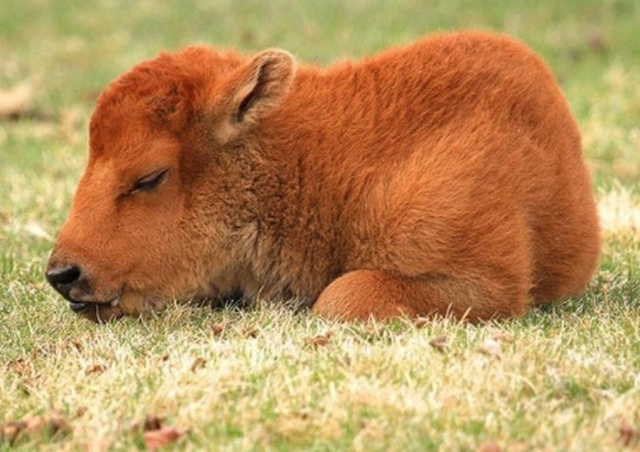
Baby Bison
Baby Starfish
Can you believe how minuscule starfish are when they are born? With more than 1,500 starfish species around, which are better known as starfish, it is no surprise that you can find them almost anywhere in the world. This extends from the freezing shallows of the poles to the warm tropics. These oceanic invertebrates consist of a middle disk from which five appendages extend. There are some species that possess weapons. As for their coloring, they can be dark and dull as well as bright and vibrant.

Baby Starfish
Baby Parrots
Parrots are another incredibly diverse group of birds that consists of around 398 individual species. Both subtropical and tropical regions are the main habitats when it comes to parrots. Parrots are most fond of nuts, buds, seeds, vegetables, and a variety of plant materials. Some select parrot species will eat carrion and rodents when needed. It is within tree hollows that parrots will generally lay their white eggs. They then hatch into these happy and chirpy baby chicks!

Baby Parrots
Baby Klipspringer
Southern and eastern Africa are the places where this diminutive antelope can be discovered. Those that look closely at this beautiful grazer’s yellow-brown fur will realize just how well adapted it is to camouflage in the arid regions where it lives. The klipspringer is unique in the antelope world due to its brittle and hollow hairs that make up its dense and coarse fur. It has spiky and short horns. These antelopes are also nocturnal that will rest throughout the sunshine period and come out when the moon is well on its journey.
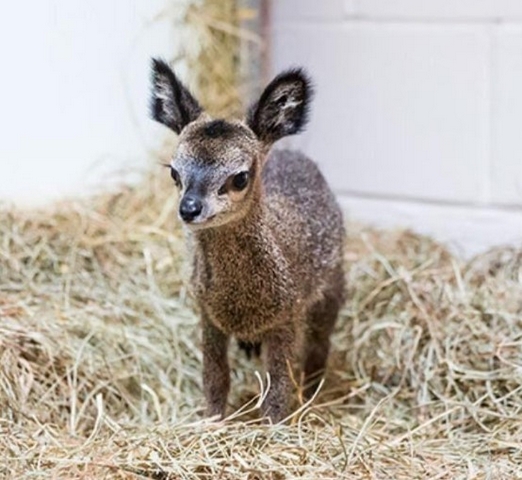
Baby Klipspringer



